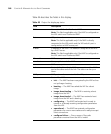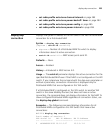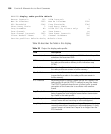
252 CHAPTER 9: MANAGED ACCESS POINT COMMANDS
Usage — For simplicity, this command displays a single entry for each
3Com radio, even if the radio is supporting multiple BSSIDs. However,
BSSIDs for third-party 802.11 radios are listed separately, even if a radio is
supporting more than one BSSID.
Information is displayed for a radio if the radio sends beacon frames or
responds to probe requests. Even if a radio’s SSIDs are unadvertised,
3Com radios detect the empty beacon frames (beacon frames without
SSIDs) sent by the radio, and include the radio in the neighbor list.
Examples — The following command displays neighbor information for
radio 1 on the directly connected MAP access point on port 2:
WX1200# display auto-tune neighbors ap 2 radio 1
Total number of entries for port 2 radio 1: 5
Channel Neighbor BSS/MAC RSSI
------- ----------------- ----
1 00:0b:85:06:e3:60 -46
1 00:0b:0e:00:0a:80 -78
1 00:0b:0e:00:d2:c0 -74
1 00:0b:85:06:dd:00 -50
1 00:0b:0e:00:05:c1 -72
Table 51 describes the fields in this display.
See Also
display auto-tune attributes on page 249
display radio-profile on page 257
set {ap | dap} radio auto-tune max-power on page 270
set {ap | dap} radio auto-tune max- retransmissions on page 271
set radio-profile auto-tune channel-config on page 281
set radio-profile auto-tune channel-holddown on page 282
Table 51 Output for display auto-tune neighbors
Field Description
Channel Channel on which the BSSID is detected.
Neighbor BSS/MAC BSSID detected by the radio.
RSSI Received signal strength indication (RSSI), in decibels referred
to 1 milliwatt (dBm). A higher value indicates a stronger
signal.


















